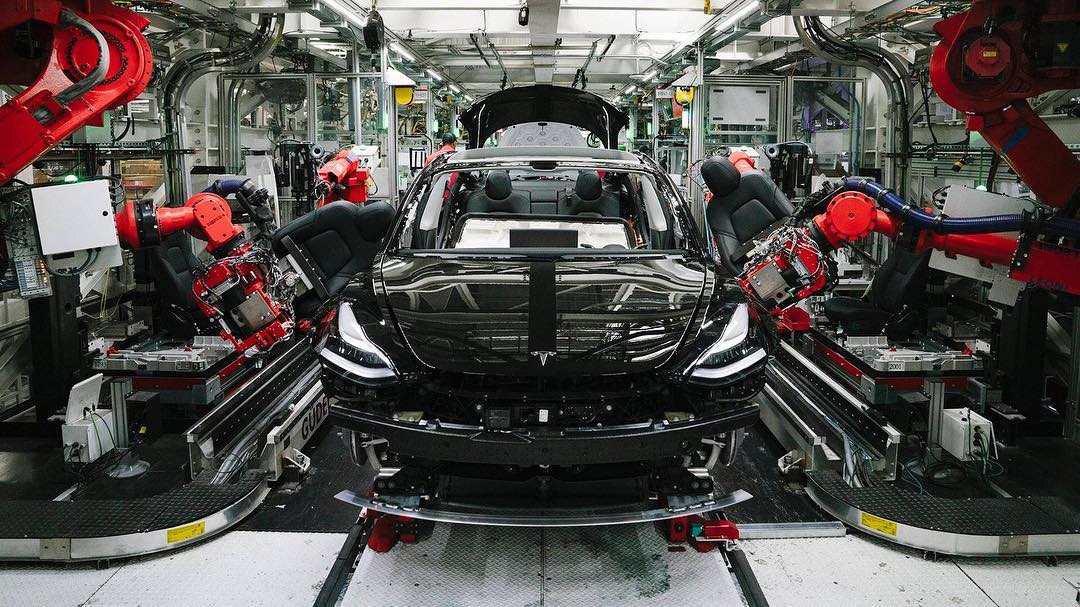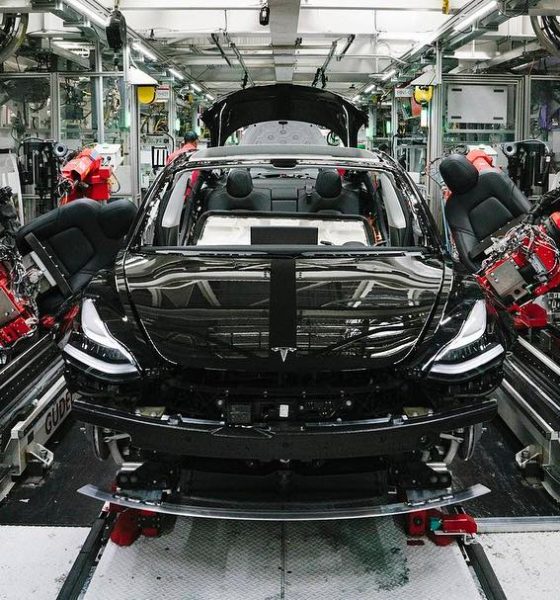

Investor's Corner
Tesla’s steadily-improving Model 3 production ramp is starting to win over Wall St.
True to Elon Musk’s words last month about the challenges Tesla faced during the Model 3 ramp, the company appears to be well on its way to leaving its self-imposed “production hell.” As Tesla’s Model 3 production shows more encouraging signs, Wall Street appears to be adopting an increasingly optimistic outlook on the electric car and energy company.
Amidst the noise surrounding Elon Musk’s tweets about the funding for Tesla’s possible privatization being secured, the company is steadily making progress in an area that matters a lot this Q3 — the Model 3 production ramp. Tesla is currently attempting to hit profitability this Q3, and being the vehicle expected to comprise most of Tesla’s electric car sales for the quarter, the Model 3 is key to this goal.
Tesla was finally able to hit its self-imposed target of producing 5,000 Model 3 per week during the final week of June. When the company released its Q2 production and deliveries report, some Wall St. analysts promptly expressed their doubts about the company’s capability to sustain the car’s optimum production rate. In the weeks that followed the release of the Q2 production and deliveries report, Tesla showed signs that it is capable of sustaining the optimum production pace of the Model 3. Hiring was ramped, more than 19,000 new Model 3 VINs were filed in a 2-week period, test drives for the Model 3 were started, and programs such as the 5-minute Sign & Drive delivery system were adopted. The Model 3’s sustained production was ultimately confirmed in the Q2 earnings call when Musk noted that Tesla was able to manufacture 5,000 Model 3 per week during “multiple weeks” in July.
Tesla has exhibited the same encouraging signs this August. Just recently, the company registered a record 16,000 new Model 3 VINs in a seven-day period — a feat that took the company roughly eight months to accomplish when it first started producing the electric car. Tesla appears to have begun initiatives to bring the Model 3 overseas as well, with viewings being scheduled for Australia and New Zealand. Even more recently, George Galliers of Evercore ISI, after a tour of the Fremont factory, released a note stating that Tesla is likely well on its way to achieving a steady weekly production rate of 5,000-6,000 Model 3 per week. The analyst even noted that despite the controversy over the company’s possible privatization, the fundamentals of Tesla’s operations are encouraging.
“Tesla seems well on the way to achieving a steady weekly production rate of 5,000 to 6,000 units per week. We are incrementally positive on Tesla following our visit. We have confidence in their production. We did not see anything to suggest that Model 3 cannot reach 6k units per week and 7k to 8k with very little incremental capital expenditure. Focusing on the fundamentals and setting aside talk of privatization, we are incrementally positive on Tesla following our visit.”
The Evercore ISI analyst is not alone in his optimistic outlook on Tesla, either. Sanford C. Bernstein analyst Toni Sacconaghi, who previously had a $265 price target for Tesla stock (NASDAQ:TSLA), recently raised his price target for the company to $325 per share. Sacconaghi is not even an avid supporter of Elon Musk, being one of the analysts who attracted the CEO’s ire during the now-infamous Q1 earnings call, where he asked what Musk described as “boneheaded” questions.
Jefferies Financial Group also lifted their price objective for Tesla from a conservative $250 to an optimistic $360 in a report issued last week. The firm also gave Tesla stock a “Neutral” rating. Berenberg Bank reissued a “Buy” rating for Tesla stock, placing a price objective of $500 for the company’s shares. JPMorgan Chase & Co., which still has a “Sell” rating on TSLA, raised its price target to $308, a significant increase from its previous price target of $195.
While Tesla stock remains a battleground between the company’s supporters and critics, Wall Street seems to be showing signs that it is starting to adopt a more optimistic stance on the electric car maker. If the company’s new price targets from Wall Street are any indication, it appears that even firms that have been critical of Tesla are starting to recognize and acknowledge the progress the electric car maker is making. If Tesla nails its Model 3 targets this Q3 by sustaining the vehicle’s production at a rate of 5,000 units per week or more, Elon Musk’s vision of a profitable Tesla might actually come true.
As of writing, Tesla stock is trading up 0.51% at $340.43 per share.
Disclosure: I have no ownership in shares of TSLA and have no plans to initiate any positions within 72 hours.

Investor's Corner
Tesla stock closes at all-time high on heels of Robotaxi progress

Tesla stock (NASDAQ: TSLA) closed at an all-time high on Tuesday, jumping over 3 percent during the day and finishing at $489.88.
The price beats the previous record close, which was $479.86.
Shares have had a crazy year, dipping more than 40 percent from the start of the year. The stock then started to recover once again around late April, when its price started to climb back up from the low $200 level.
This week, Tesla started to climb toward its highest levels ever, as it was revealed on Sunday that the company was testing driverless Robotaxis in Austin. The spike in value pushed the company’s valuation to $1.63 trillion.
Tesla Robotaxi goes driverless as Musk confirms Safety Monitor removal testing
It is the seventh-most valuable company on the market currently, trailing Nvidia, Apple, Alphabet (Google), Microsoft, Amazon, and Meta.
Shares closed up $14.57 today, up over 3 percent.
The stock has gone through a lot this year, as previously mentioned. Shares tumbled in Q1 due to CEO Elon Musk’s involvement with the Department of Government Efficiency (DOGE), which pulled his attention away from his companies and left a major overhang on their valuations.
However, things started to rebound halfway through the year, and as the government started to phase out the $7,500 tax credit, demand spiked as consumers tried to take advantage of it.
Q3 deliveries were the highest in company history, and Tesla responded to the loss of the tax credit with the launch of the Model 3 and Model Y Standard.
Additionally, analysts have announced high expectations this week for the company on Wall Street as Robotaxi continues to be the focus. With autonomy within Tesla’s sights, things are moving in the direction of Robotaxi being a major catalyst for growth on the Street in the coming year.
Elon Musk
Tesla needs to come through on this one Robotaxi metric, analyst says
“We think the key focus from here will be how fast Tesla can scale driverless operations (including if Tesla’s approach to software/hardware allows it to scale significantly faster than competitors, as the company has argued), and on profitability.”

Tesla needs to come through on this one Robotaxi metric, Mark Delaney of Goldman Sachs says.
Tesla is in the process of rolling out its Robotaxi platform to areas outside of Austin and the California Bay Area. It has plans to launch in five additional cities, including Houston, Dallas, Miami, Las Vegas, and Phoenix.
However, the company’s expansion is not what the focus needs to be, according to Delaney. It’s the speed of deployment.
The analyst said:
“We think the key focus from here will be how fast Tesla can scale driverless operations (including if Tesla’s approach to software/hardware allows it to scale significantly faster than competitors, as the company has argued), and on profitability.”
Profitability will come as the Robotaxi fleet expands. Making that money will be dependent on when Tesla can initiate rides in more areas, giving more customers access to the program.
There are some additional things that the company needs to make happen ahead of the major Robotaxi expansion, one of those things is launching driverless rides in Austin, the first city in which it launched the program.
This week, Tesla started testing driverless Robotaxi rides in Austin, as two different Model Y units were spotted with no occupants, a huge step in the company’s plans for the ride-sharing platform.
Tesla Robotaxi goes driverless as Musk confirms Safety Monitor removal testing
CEO Elon Musk has been hoping to remove Safety Monitors from Robotaxis in Austin for several months, first mentioning the plan to have them out by the end of 2025 in September. He confirmed on Sunday that Tesla had officially removed vehicle occupants and started testing truly unsupervised rides.
Although Safety Monitors in Austin have been sitting in the passenger’s seat, they have still had the ability to override things in case of an emergency. After all, the ultimate goal was safety and avoiding any accidents or injuries.
Goldman Sachs reiterated its ‘Neutral’ rating and its $400 price target. Delaney said, “Tesla is making progress with its autonomous technology,” and recent developments make it evident that this is true.
Investor's Corner
Tesla gets bold Robotaxi prediction from Wall Street firm
Last week, Andrew Percoco took over Tesla analysis for Morgan Stanley from Adam Jonas, who covered the stock for years. Percoco seems to be less optimistic and bullish on Tesla shares, while still being fair and balanced in his analysis.

Tesla (NASDAQ: TSLA) received a bold Robotaxi prediction from Morgan Stanley, which anticipates a dramatic increase in the size of the company’s autonomous ride-hailing suite in the coming years.
Last week, Andrew Percoco took over Tesla analysis for Morgan Stanley from Adam Jonas, who covered the stock for years. Percoco seems to be less optimistic and bullish on Tesla shares, while still being fair and balanced in his analysis.
Percoco dug into the Robotaxi fleet and its expansion in the coming years in his latest note, released on Tuesday. The firm expects Tesla to increase the Robotaxi fleet size to 1,000 vehicles in 2026. However, that’s small-scale compared to what they expect from Tesla in a decade.
Tesla expands Robotaxi app access once again, this time on a global scale
By 2035, Morgan Stanley believes there will be one million Robotaxis on the road across multiple cities, a major jump and a considerable fleet size. We assume this means the fleet of vehicles Tesla will operate internally, and not including passenger-owned vehicles that could be added through software updates.
He also listed three specific catalysts that investors should pay attention to, as these will represent the company being on track to achieve its Robotaxi dreams:
- Opening Robotaxi to the public without a Safety Monitor. Timing is unclear, but it appears that Tesla is getting closer by the day.
- Improvement in safety metrics without the Safety Monitor. Tesla’s ability to improve its safety metrics as it scales miles driven without the Safety Monitor is imperative as it looks to scale in new states and cities in 2026.
- Cybercab start of production, targeted for April 2026. Tesla’s Cybercab is a purpose-built vehicle (no steering wheel or pedals, only two seats) that is expected to be produced through its state-of-the-art unboxed manufacturing process, offering further cost reductions and thus accelerating adoption over time.
Robotaxi stands to be one of Tesla’s most significant revenue contributors, especially as the company plans to continue expanding its ride-hailing service across the world in the coming years.
Its current deployment strategy is controlled and conservative to avoid any drastic and potentially program-ruining incidents.
So far, the program, which is active in Austin and the California Bay Area, has been widely successful.








